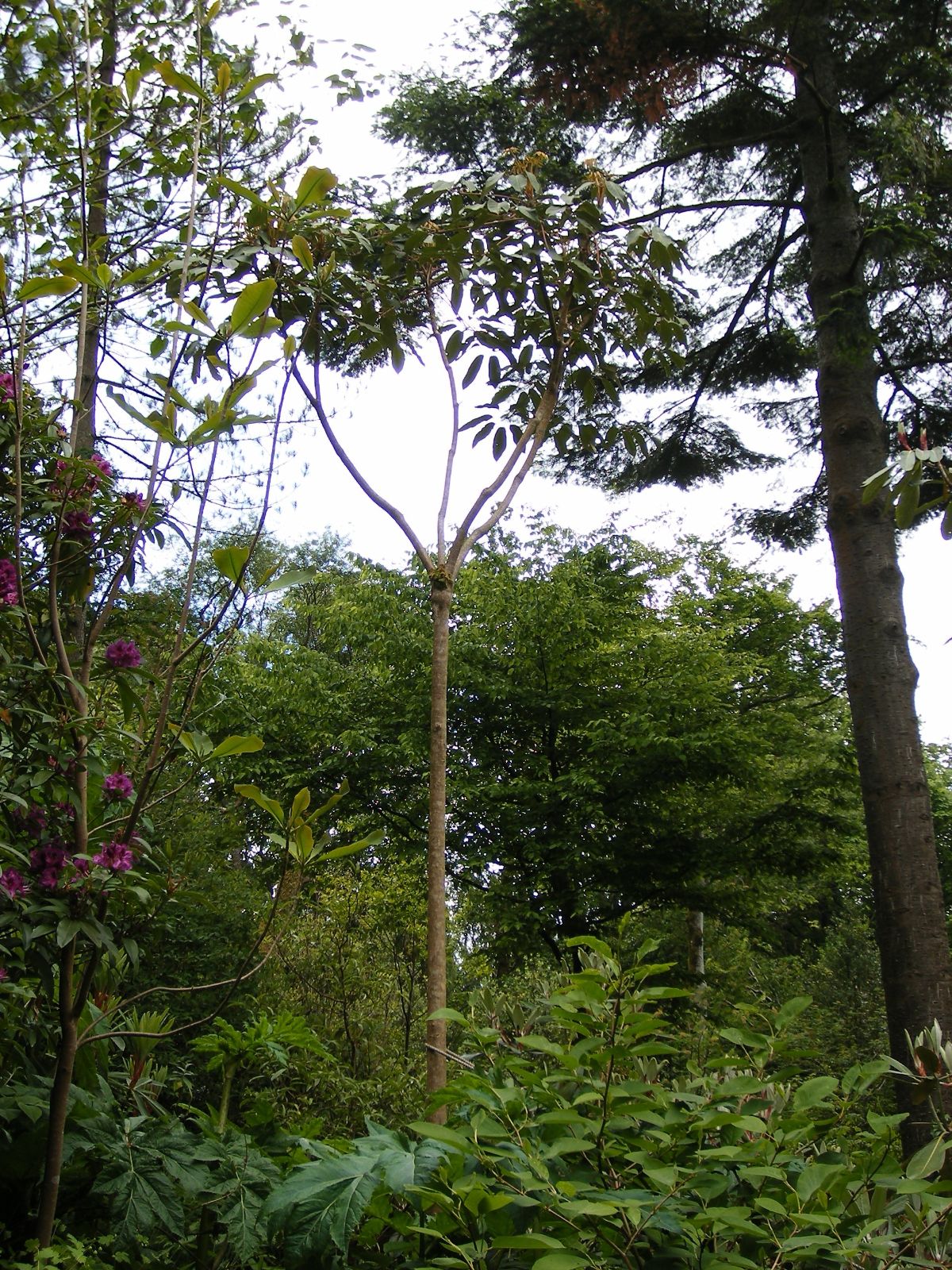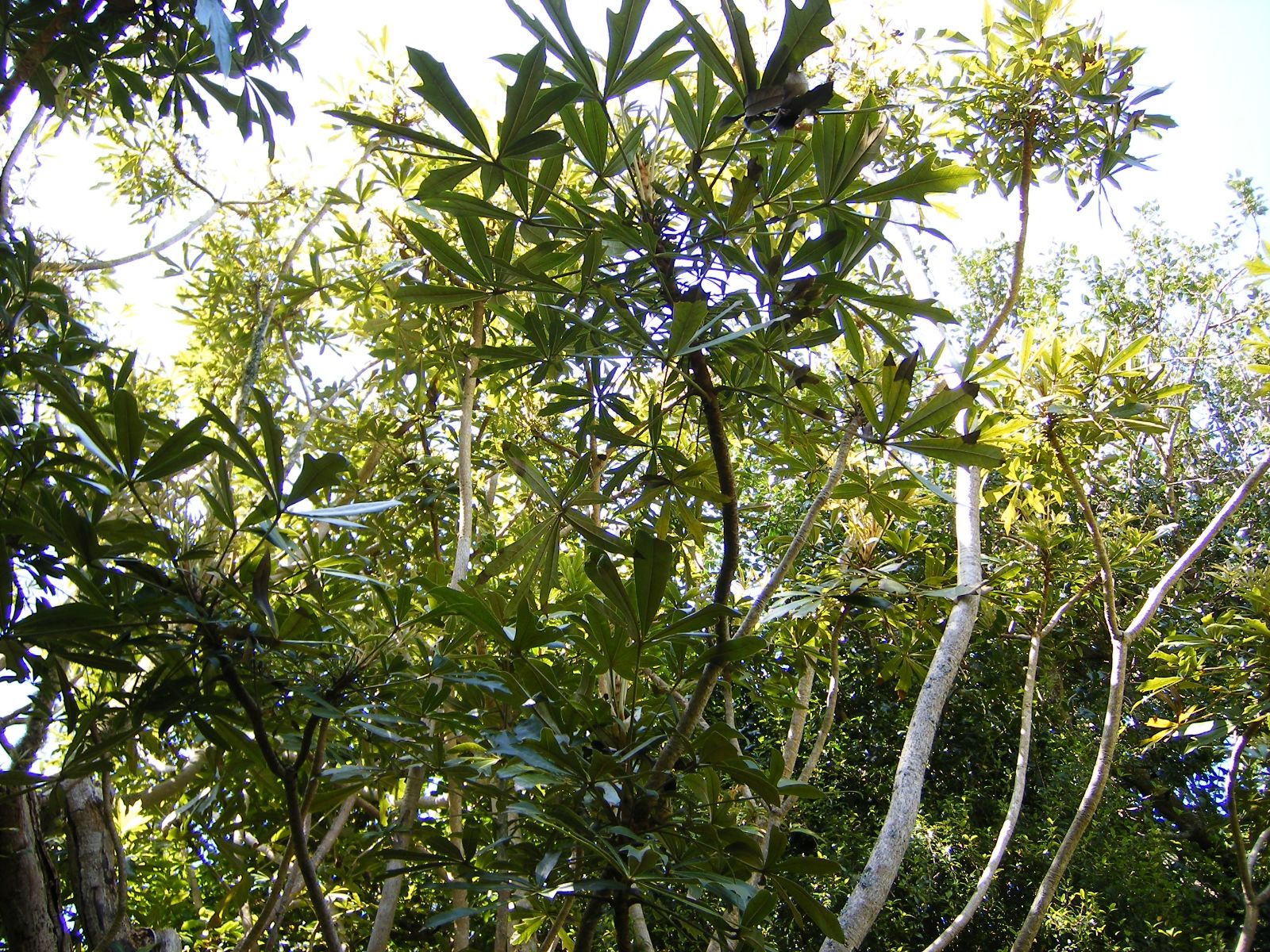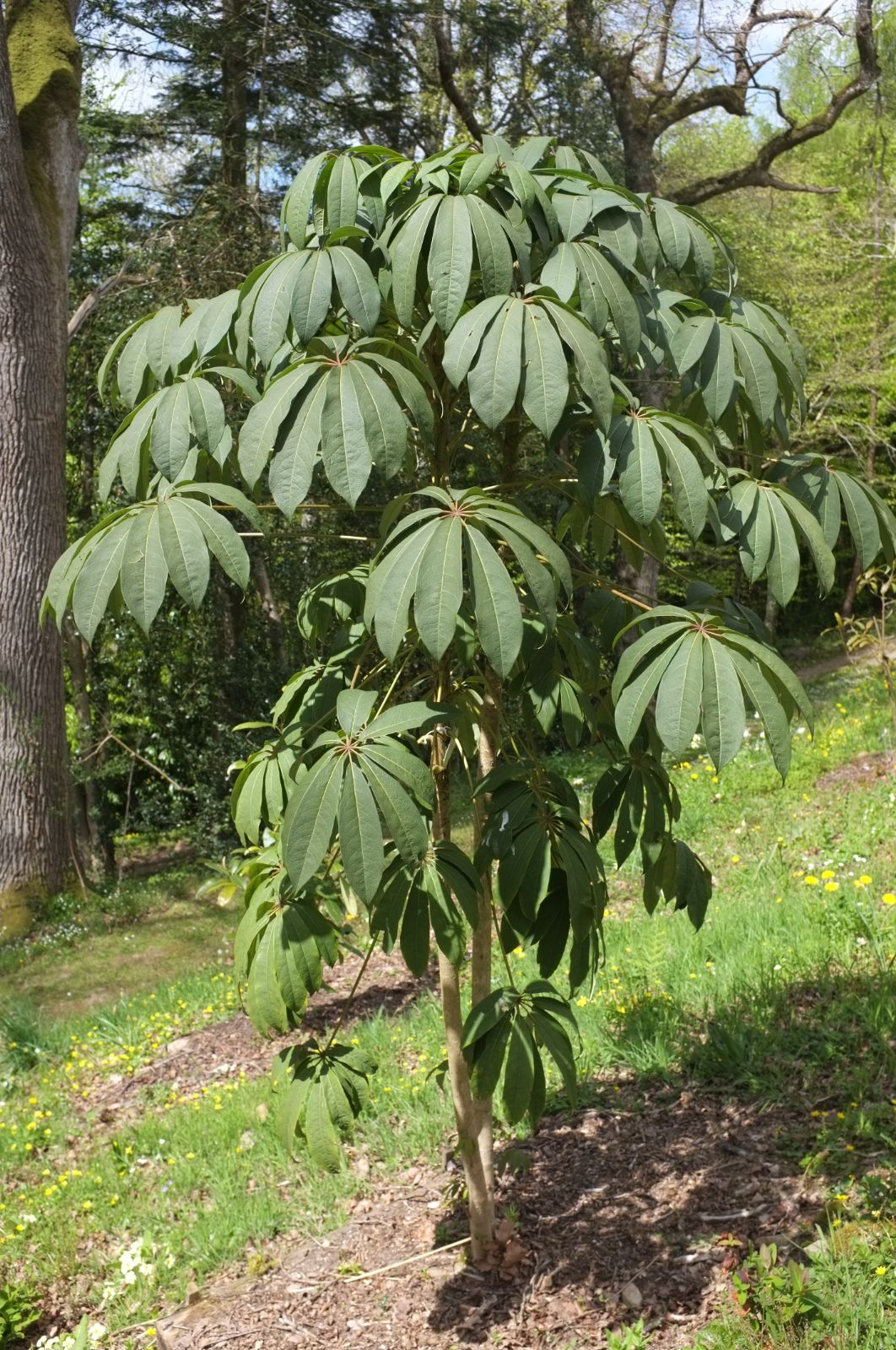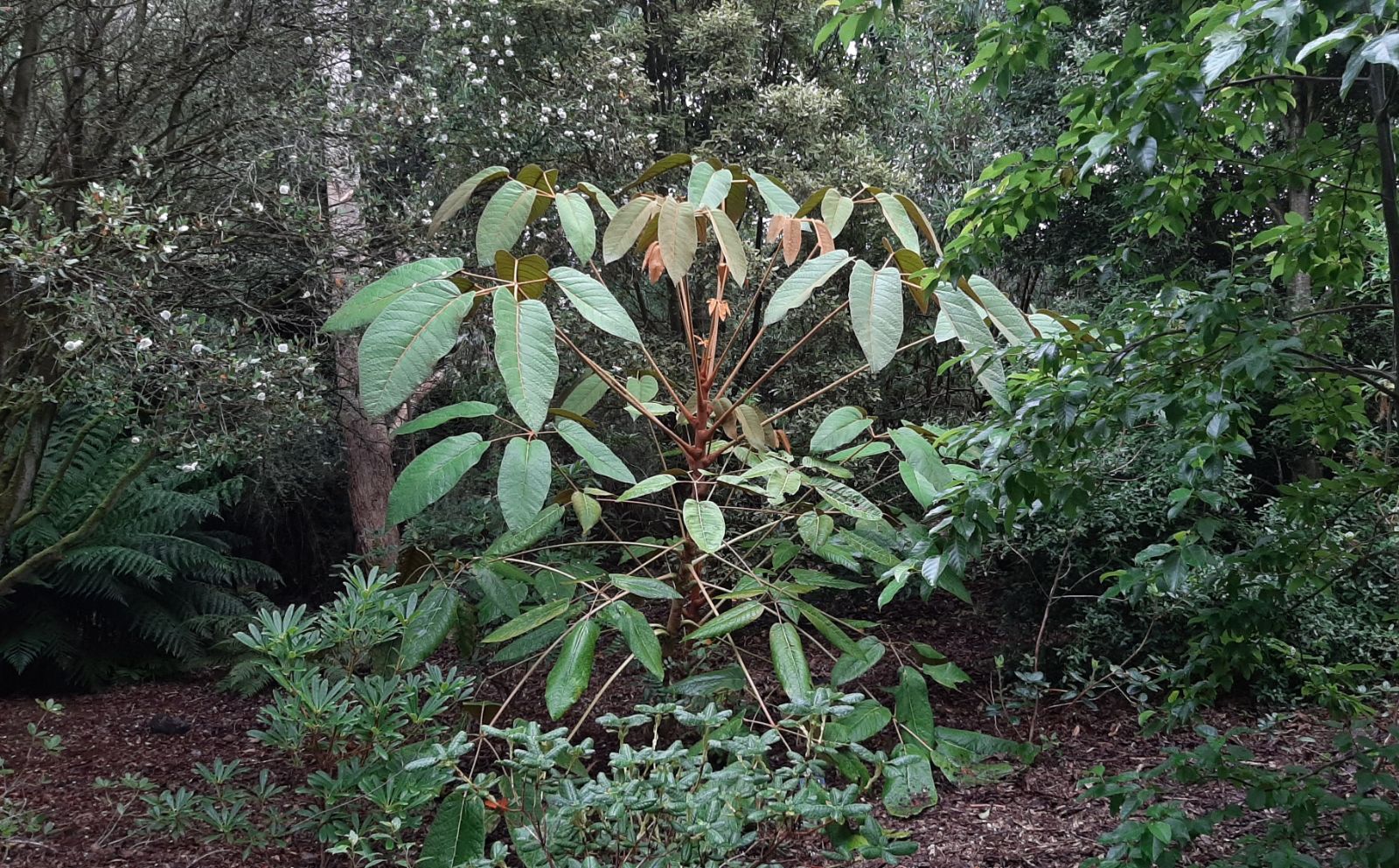Schefflera
Credits
Article from New Trees by John Grimshaw & Ross Bayton
Recommended citation
'Schefflera' from the website Trees and Shrubs Online (treesandshrubsonline.
Family
- Araliaceae
Common Names
- Umbrella Trees
The World Checklist of Araliaceae (Frodin et al. 2003) lists 582 species of Schefflera, and many new species are still to be described. The genus occurs in all of the tropical and subtropical regions of the world, but it is less well represented in Africa. Schefflera are usually small trees or shrubs, though woody climbers and perennial herbs are known. They are evergreen, unarmed and hermaphrodite, or with both male and hermaphrodite flowers on the same plant. The leaves are palmately compound (rarely unifoliolate) and the leaflets are entire to serrate; stipules are united with the petiole. Flowers are arranged in umbels, heads or racemes, which in turn are arranged in panicles or compound racemes; the inflorescences bear deciduous or persistent bracts. The flowers are pedicellate (pedicel not articulated below flower), with an entire or five-toothed calyx, 5–11 valvate petals and 5–11 stamens. The fruit is a globose or ovoid drupe, with (4–)5–11 seeds (Ohashi 1993c, Xiang & Lowry 2006). The genus has been shown to be polyphyletic by several studies, and should be restricted to species from the southwestern Pacific area. The Asian species form a distinct clade, however, so should bear the same generic name, once the appropriate revisions have been made (see Xiang & Lowry 2006).
Only a few years ago the idea of a hardy Schefflera would have been considered almost absurd – The New RHS Dictionary of Gardening (Huxley et al. 1992) advising that ‘In colder areas they may be cultivated in the intermediate to hot glasshouse …’ Less than two decades later though, they are ‘must-have’ plants, without which, apparently, no garden is complete. Some are, indeed, making a genuine impact, and the enthusiasm of the moment will no doubt lead to the testing of a wide range of possibilities, from which survivors will emerge.
Hardy scheffleras were pioneered by introductions of the late Edward Needham some 20 years ago, in whose sheltered Cornish garden S. delavayi, S. rhododendrifolia and S. taiwaniana have formed impressive specimens, admired by many. Cuttings from them were gently passed around the horticultural community, and these clones have now entered commerce. In consequence these three species have become the best known and are the most tested; all have proved to be reliably hardy in many parts of the British Isles, and can therefore be expected to grow successfully in coastal western Europe and the Pacific Northwest. More recently, the potential of the genus has been most extensively explored by Bleddyn and Sue Wynn-Jones of Crûg Farm Plants in Gwynedd. Perceiving the possibilities, they have made Schefflera a priority on their collecting trips, and it is no coincidence that in the RHS Plant Finder 2008–2009, of 29 entries for taxa available in British nurseries (some of which are indubitably tender species for indoor cultivation), 18 are offered exclusively by Crûg Farm. The genus has been less readily available in North America, although numerous species are now in cultivation there. The ease with which they are grown from seed and cuttings is likely to ensure that they continue to be distributed widely.
With their exceptionally handsome palmate to digitate leaves, and distinctive outlines, it is no wonder that Schefflera species have caught the imagination of the gardening public as well as garden designers, bringing new shapes and forms into horticulture. Although they are grown principally as foliage plants, their inflorescences can also be quite ornamental. The individually small flowers are succeeded by round fruits that are usually blackish purple like those of their relatives Hedera L. and Fatsia Decne & Planch., but can occur in a variety of colours (Wynn-Jones 2005). When ripe these are both decorative and monetarily valuable.
In the wild, many if not most species of Schefflera are pioneers, colonising open, disturbed places and forming the best-looking plants in such sites. Examples seen in forest conditions are usually drawn and scrawny (B. Wynn-Jones, pers. comm. 2008). In consequence they should not be considered to be shade plants, and even in the woodland garden should be given a sunny site – though where sunlight is very intense (as in the Pacific Northwest) some high light shade may be appropriate. Ample moisture is necessary for success, however, and it is important not to be tempted into planting them in a hot sunny place that may become dry; all Schefflera come from moist areas. A sheltered warm site with good soil and water supplies is optimal. Poor drainage must be avoided, and they do not like clay soils (B. Wynn-Jones, pers. comm. 2008). It is probably wise to grow young plants in pots for a couple of years before planting out, to ensure that they have a woody base from which regrowth could occur should they be badly frosted, and to protect them against cold winds and heavy frost when young. Wind at any time is damaging, to the large-leaved species especially, so these should be sited in sheltered places. Late frost can be a danger to new shoots – but this problem is not exclusive to Schefflera. It is important to bear in mind that few of these species have been really comprehensively tested in gardens, and their true tolerances will only become apparent in future years. In the United States, at least, Strawberry Root Weevil (Otiorhynchus ovatus) is damaging to the foliage of Schefflera (D. Hinkley, pers. comm. 2008), and it is possible that other Otiorhynchus weevils could be a nuisance elsewhere.
A selection of reasonably well-tested Asian species are described in full below, but there are many other species worthy of consideration and investigation, either currently in cultivation, or as yet un-introduced, from high altitudes in mountains across the tropics and subtropics. Northern Vietnam, especially Fan Si Pan and its surroundings, has been a particularly rich source of material for the Wynn-Joneses, but some introductions have as yet been only tentatively identified and will probably not be confirmed until they flower. Among these are several taxa that seem to form a closely related group, whose identities are by no means certain. These include S. aff. brevipedicellata HWJ 1870, a shrubby species to 2 m; and S. aff. enneaphylla HWJ 1018, a shrub to 3 m in the wild, and notable for its extra false-whorl of leaflets overlapping the primary leaflets, giving a multilayered effect. Young plants of the latter have not proven very vigorous in pots under cover at Colesbourne, Gloucestershire, and emerging leaves were burnt during hot weather in May 2008. An expedition in 2000 led to the collection of another of this group, identified as S. fantsipanensis Bui BSWJ 8228, which has been written up (Wynn-Jones 2005) under the name S. hoi (Dunn) R. Vig. var. fantsipanensis (Bui) C.B. Shang. This forms a single-stemmed small tree to 5 m, on open slopes as well as in forest, from about 2000–2400 m asl, and has survived for several years at Crûg Farm. Another taxon with an extra ring of leaflets, collected in 1999 as HWJ 622, has been identified as S. gracilis (Miq.) R. Vig., but the World Checklist of Araliaceae restricts this name to a climbing species from Borneo. On Fan Si Pan this plant occurred only up to 2200 m but it has tolerated –11 ºC at Crûg Farm, and has survived outside for several winters there (Wynn-Jones 2005). In Dan Hinkley’s garden near Seattle the same taxon has flowered and fruited in its second year, when only 45 cm high; the effect is quite ornamental, but does not bode well for the development of a good plant (D. Hinkley, pers. comm. 2008). In the wild it is a low shrub to 1.5 m. Also found in the Fan Si Pan area is a different group of scheffleras, related to S. alpina (see below), and the Wynn-Joneses have seen other species on the mountain as well, seed of which they have not yet been able to obtain (B. Wynn-Jones, pers. comm. 2008). From southern Vietnam comes S. aff. lenticellata BSWJ 9762 (introduced in 2003), a robust shrub or small tree with heavily lenticellate green stems. (Much of the information for this paragraph derives from the Crûg Farm Plants online database (2007–2008) or personal communications with Bleddyn Wynn-Jones.)
The milder the garden, the wider the range of options in Schefflera, as several species tolerate cold temperatures but only a few degrees of frost. These include S. arboricola (Hayata) Merr. from Hainan and Taiwan (frequently grown as a long-suffering houseplant, often in the form of variegated cultivars), and the Philippine cloud-forest semi-climbing shrub S. microphylla Merr. These are severely damaged at only –5 ºC (Wynn-Jones 2005). The New Zealand S. digitata J.R. Forst & G. Forst. is also not very hardy, but in practically frost-free situations can develop into a fine specimen; the largest recorded in the British Isles was 15 m tall, measured at Ashbourne House Hotel, Co. Cork in 1987, and there is a 9 m tree at Tresco Abbey on the Isles of Scilly (Johnson 2007). A very beautiful plant of S. bodinieri (H. Lév.) Rehder from Guizhou, with long narrow leaflets, grows in the Temperate House at Kew, and enthusiasts are itching to try it outside. No doubt further introductions will appear, but it should be noted that identification can be difficult – inadequate descriptions supplementing the problems associated with variability and the occurrence in some species of distinct juvenile and adult foliage.
The ease with which Schefflera can be propagated is very helpful in building up a stock with which to experiment. Cuttings root very readily but suitable material, especially of the larger species, can be sparse and difficult to manage: for the brave, however, one possibility is to decapitate the main stem and take cuttings from the axillary shoots that develop. Seed is generally an easier option, if it is available.
Connected only by its family relationship and its initial S, Sinopanax is a monospecific genus comprising S. formosanus (Hayata) H.L. Li, found in Taiwan. This has handsome firm-textured grey-green leaves that are wedge-shaped or rounded in outline, with three to five toothed lobes. It is in cultivation in both the United Kingdom and the United States, in the mild western extremities of each, as might be expected, but needs to be tested further afield. It is hardy at Crûg Farm, but both cutting material and seed are sparse and this has delayed its commercial introduction (B. Wynn-Jones, pers. comm. 2008). Although usually a shrub, 3–4 m tall and broad, it can form a tree to 12 m (Xiang & Lowry 2006). Trevesia palmata (Roxb. ex Lindl.) Vis., known as the Snowflake Tree on account of the regular pattern of its pinnatisect leaflets, is more closely related to Schefflera, and is a magnificent foliage plant – exceptional even within the Araliaceae. From within its huge range, from India through southern China to Vietnam, high-altitude provenances should be sought: a hardy version would be an unparalleled coup for its collector. It is currently rated Zone 10 (Huxley et al. 1992) and is grown outdoors in California and the Mediterranean, as well as under glass in botanic gardens. It would certainly be worth attempting in the mildest parts of our area, but other species from higher altitudes may be more promising (B. Wynn-Jones, pers. comm. 2008).




